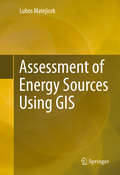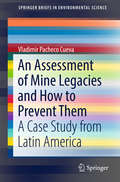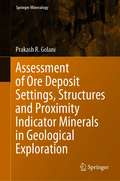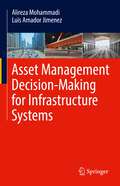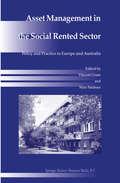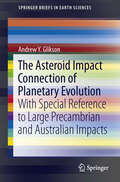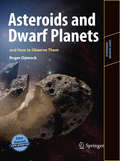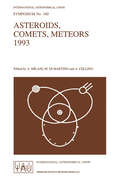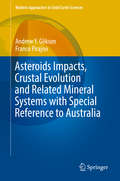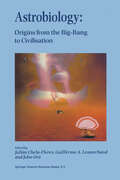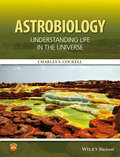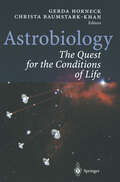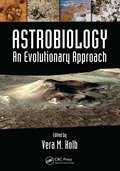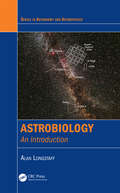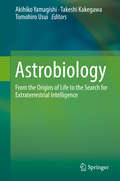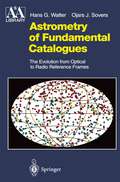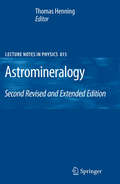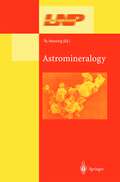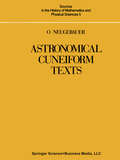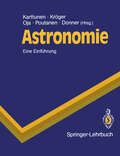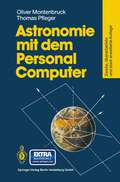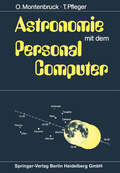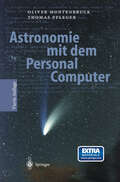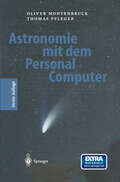- Table View
- List View
Assessment of Energy Sources Using GIS
by Lubos MatejicekThis volume is a comprehensive guide to the use of geographic information systems (GIS) for the spatial analysis of supply and demand for energy in the global and local scale. It gathers the latest research and techniques in GIS for spatial and temporal analysis of energy systems, mapping of energy from fossil fuels, optimization of renewable energy sources, optimized deployment of existing power sources, and assessment of environmental impact of all of the above. Author Lubos Matejicek covers GIS for assessment a wide variety of energy sources, including fossil fuels, hydropower, wind power, solar energy, biomass energy, and nuclear power as well as the use of batteries and accumulators. The author also utilizes case studies to illustrate advanced techniques such as multicriteria analysis, environmental modeling for prediction of energy consumption, and the use of mobile computing and multimedia tools.
An Assessment of Mine Legacies and How to Prevent Them: A Case Study from Latin America (SpringerBriefs in Environmental Science)
by Vladimir Pacheco CuevaThis book seeks to enrich the growing literature on mine legacies by examining a case study of a small abandoned mine in Latin America. Using a combination of Rapid Rural Appraisal and secondary source analysis, this study assessed some of the most damaging legacies of the San Sebastian mine in eastern El Salvador, compared the country’s mine closure legislation against world’s best practice standards and provided strategies for awareness, prevention and remediation. The most damaging legacy to the environment is that of Acid Mine Drainage (AMD) contamination of the local river. The impact of AMD is felt well beyond the mining district and the costs of prevention and remediation were found to be significant. Apart from environmental legacies, the mine also left a number of socio-economic legacies including: limited access to non-polluted water that results in San Sebastian residents devoting a high proportion of their income in obtaining water, lost opportunities due to the cessation of mining, uncertain land tenure situation and increasing growth of ASGM activities that exacerbate already existing environmental pollution due to use of mercury. The study also found that the state’s capacity to ensure compliance with the law is very weak and that in many important respects the country’s current legal framework does not meet world’s best practice when it comes to mine closure requirements.The findings are important because they demonstrate that the lack of closure planning can lead to private operators socializing the costs of pollution. The study also shows that the lack of state capacity may result in extractive projects becoming socio-economic liabilities in the long term.
Assessment of Ore Deposit Settings, Structures and Proximity Indicator Minerals in Geological Exploration (Springer Mineralogy)
by Prakash R. GolaniThis well-illustrated book aims to enhance observations and understanding of structural features and proximity-indicator minerals, critical in exploration. The book provides a unique blending of different content on observational and critical aspects of data acquisition, geological, structural, tectonic set-up, mineral deposit types, geophysical framework, and proximity indicator minerals. Combining these topics led to a comprehensive understanding to facilitate mineral targeting and exploration in green- and brown-field terrains. Besides field photographs, the write-up is lavishly supplemented with relevant geological and geophysical maps, tables, and case stories in field geology, making it useful for a much larger section of the geoscientific community professional geologists and geophysicists, students, teachers, and also decision-makers in geo-surveys and exploration.
Asset Management Decision-Making For Infrastructure Systems
by Alireza Mohammadi Luis Amador JimenezThis textbook provides practical and concrete guidance for the step-by-step implementation of decision-making for infrastructure asset management. Examples are used to illustrate how data from condition assessment are used to develop performance models, to estimate the effectiveness of investments that are prioritized and scheduled to accomplish reliable and convenient infrastructure for the wellbeing of the public and regional economic competitiveness. Book illustrates numerous worked problems to clarify ambiguity in developing a decision-making platform to prioritize assets and distribute budgets effectively and efficiently.Ensures reader understanding of the benefits and challenges of infrastructure asset management; Provides a step-by-step guide for the development of each component of an asset management decision-making system;Includes worked examples to clarify decision-making and budget allocation process.
Asset Management in the Social Rented Sector: Policy and Practice in Europe and Australia
by NicoNieboer VincentGruisThis book fills an important gap in housing research, covering the impact of recent changes in housing policies and markets on the development of state-of-the-art asset management within the social rented sector in various countries.
The Asteroid Impact Connection of Planetary Evolution: With Special Reference to Large Precambrian and Australian impacts (SpringerBriefs in Earth Sciences)
by Andrew Y. GliksonWhen in 1981 Louis and Walter Alvarez, the father and son team, unearthed a tell-tale Iridium-rich sedimentary horizon at the 65 million years-old Cretaceous-Tertiary boundary at Gubbio, Italy, their find heralded a paradigm shift in the study of terrestrial evolution. Since the 1980s the discovery and study of asteroid impact ejecta in the oldest well-preserved terrains of Western Australia and South Africa, by Don Lowe, Gary Byerly, Bruce Simonson, Scott Hassler, the author and others, and the documentation of new exposed and buried impact structures in several continents, have led to a resurgence of the idea of the catastrophism theory of Cuvier, previously largely supplanted by the uniformitarian theory of Hutton and Lyell. Several mass extinction of species events are known to have occurred in temporal proximity to large asteroid impacts, global volcanic eruptions and continental splitting. Likely links are observed between asteroid clusters and the 580 Ma acritarch radiation, end-Devonian extinction, end-Triassic extinction and end-Jurassic extinction. New discoveries of ~3.5 – 3.2 Ga-old impact fallout units in South Africa have led Don Lowe and Gary Byerly to propose a protracted prolongation of the Late Heavy Bombardment (~3.95-3.85 Ga) in the Earth-Moon system. Given the difficulty in identifying asteroid impact ejecta units and buried impact structures, it is likely new discoveries of impact signatures are in store, which would further profoundly alter models of terrestrial evolution..
Asteroids and Dwarf Planets and How to Observe Them (Astronomers' Observing Guides)
by Roger DymockDwarf planets (which were formerly called asteroids except for the planet Pluto), and the smaller Solar System bodies still called asteroids today, are making front page news, particularly those that are newly discovered and those that might present a hazard to life on Earth by impacting our planet. In this age of giant telescopes and space probes, these small Solar System bodies have advanced from being tiny points of light to bodies worthy of widespread study. This book describes the dwarf planets and asteroids themselves, their origins, orbits, and composition, and at how amateur astronomers can play a part in their detection, tracking, and imaging. The book is divided into two parts. Part I describes physical properties (including taxonomic types) of dwarf planets and asteroids, how they formed in the early life of the Solar System, and how they evolved to their present positions, groups, and families. It also covers the properties used to define these small Solar System bodies: magnitude, rotation rates (described by their light-curves), and orbital characteristics. Part II opens with a description of the hardware and software an amateur or practical astronomer needs to observe and also to image asteroids. Then numerous observing techniques are covered in depth. Finally, there are lists of relevant amateur and professional organizations and how to submit your own observations to them.
Asteroids, Comets, Meteors 1993: Proceedings of the 160th Symposium of the International Astronomical Union, Held in Belgirate, Italy, June 14–18, 1993 (International Astronomical Union Symposia #160)
by A. Milani Mario Badiale A. CellinoTHE MEETING The IAU Symposium 160 ASTEROIDS COMETS METEORS 1999 has been held at Villa Carlotta in Belgirate, on the shore of Lago Maggiore (Italy), from June 14 to June 18, 1993. It has been organized by the Astronomical Observatory of Torino and by the Lunar and Planetary Institute of Houston. It has been a very large meeting, with 323 registered participants from 38 countries. The scientific program included 29 invited reviews, 106 oral communications, and 215 posters. The subjects covered included all the aspects of the studies of the minor bodies of the solar system, including asteroids, comets, meteors, meteorites, interplanetary dust, with special focus on the interrelationships between these. The meeting was structured as follows. 5 morning plenary sessions have been devoted to invited reviews on: (1) search programs (2) populations of small bodies (3) dynamics (4) physical observations and modelling (5) origin and evolution. Two afternoon plenary sessions have been devoted to space missions to small bodies and to interrelationships between the different populations. The afternoon parallel sessions have been devoted to: dynamics of comets; Toutatis, Ida, Gaspra; physical processes in cometary comae and tails; meteorites; the cosmogonic message from cometary nuclei; physics of asteroids; the interplanetary dust complex; comet nuclei; meteors; composition and material properties of comets; dynamics of asteroids.
Asteroids Impacts, Crustal Evolution and Related Mineral Systems with Special Reference to Australia (Modern Approaches in Solid Earth Sciences #14)
by Andrew Y. Glikson Franco PirajnoThis book presents a comprehensive overview of Australian impact structures and related mineralization, including a discussion of the significance of many of these structures for crustal evolution. The book focuses in particular on Archaean impact ejecta/fallout units in the Pilbara Craton of Western Australia, large exposed and buried impact structures, and on the geophysical evidence for possible to probable impact structures. Thanks to their long-term geological stability, Precambrian and younger terrains in the Australian continent contain 38 confirmed impact structures and 43 ring and dome structures, many of which constitute possible to probable asteroid impact structures. The impact structures have been the subject of more than half a century of studies and range from several tens of meter-large craters to buried structures larger than 100 km in diameter. Discoveries of impact fallout units in the Pilbara Craton have defined the Pilbara as one of the two best documented terrains where Archaean impact ejecta/fallout deposits are identified, the other terrain being the Kaapvaal Craton in southern Africa. A synthesis of evidence from both cratons indicates periods of large asteroid bombardments during ~3.47 – 2.48 billion years-ago, including peak bombardment about 3.25—3.22 billion years-ago. The latter period coincides with an abrupt transformation of an early Archaean granite-greenstone crust to mid to late Archaean semi-continental crustal regimes, underpinning the significance of heavy asteroid impact events for crustal evolution. Apart from proven impact structures, Australian terrains display a range of circular features, including morphological and drainage rings, circular lakes, volcanic craters, tectonic domes, oval granite bodies, mafic igneous plugs, salt diapirs, and magnetic, gravity and seismic anomalies, many of which are of a likely impact origin. Thermal and hydrothermal processes associated with impact cratering bear important consequences for the formation of mineral deposits, such as Ni at Sudbury, Pb-Zn at Siljan and Kentland. Impact structures may also provide sites for the accumulation of hydrocarbons, whereas in some instances fracturing associated with impact structures allows outward migration of oil and gas.
Astrobiology: Origins from the Big-Bang to Civilisation Proceedings of the Iberoamerican School of Astrobiology Caracas, Venezuela, 28 November– 8 December, 1999
by Julian Chela-Flores Guillermo A. Lemarchand John OróAstrobiology: Understanding Life in the Universe (Physical Chemistry In Action Ser.)
by Charles S. CockellAstrobiology is an interdisciplinary field that asks profound scientific questions. How did life originate on the Earth? How has life persisted on the Earth for over three billion years? Is there life elsewhere in the Universe? What is the future of life on Earth?Astrobiology: Understanding Life in the Universe is an introductory text which explores the structure of living things, the formation of the elements for life in the Universe, the biological and geological history of the Earth and the habitability of other planets in our own Solar System and beyond. The book is designed to convey some of the major conceptual foundations in astrobiology that cut across a diversity of traditional fields including chemistry, biology, geosciences, physics and astronomy. It can be used to complement existing courses in these fields or as a stand-alone text for astrobiology courses. Readership: Undergraduates studying for degrees in earth or life sciences, physics, astronomy and related disciplines, as well as anyone with an interest in grasping some of the major concepts and ideas in astrobiology.
Astrobiology: Understanding Life in the Universe
by Charles S. CockellAstrobiology is an interdisciplinary field that asks profound scientific questions. How did life originate on the Earth? How has life persisted on the Earth for over three billion years? Is there life elsewhere in the Universe? What is the future of life on Earth?Astrobiology: Understanding Life in the Universe is an introductory text which explores the structure of living things, the formation of the elements for life in the Universe, the biological and geological history of the Earth and the habitability of other planets in our own Solar System and beyond. The book is designed to convey some of the major conceptual foundations in astrobiology that cut across a diversity of traditional fields including chemistry, biology, geosciences, physics and astronomy. It can be used to complement existing courses in these fields or as a stand-alone text for astrobiology courses. Readership: Undergraduates studying for degrees in earth or life sciences, physics, astronomy and related disciplines, as well as anyone with an interest in grasping some of the major concepts and ideas in astrobiology.
Astrobiology: The Quest for the Conditions of Life
by Gerda Horneck Christa Baumstark-KhanThis book bridges a gap in the literature by bringing together leading specialists from different backgrounds. It addresses the specific need for a readable book on this very interdisciplinary and new topic at research level.
Astrobiology: An Evolutionary Approach
by Vera M. KolbAstrobiology: An Evolutionary Approach provides a full course in astrobiology with an emphasis on abiogenesis and evolution. The book presents astrobiology both as a developing science and as the science of the future.The origins of life and the possibility of life elsewhere continues to be a subject of scientific and philosophical examination. The
Astrobiology: An Introduction (Series In Astronomy And Astrophysics Ser.)
by Alan LongstaffAstrobiology is a multidisciplinary pursuit that in various guises encompasses astronomy, chemistry, planetary and Earth sciences, and biology. It relies on mathematical, statistical, and computer modeling for theory, and space science, engineering, and computing to implement observational and experimental work. Consequently, when studying astrobio
Astrobiology: From the Origins of Life to the Search for Extraterrestrial Intelligence
by Akihiko Yamagishi Takeshi Kakegawa Tomohiro UsuiThis book provides concise and cutting-edge reviews in astrobiology, a young and still emerging multidisciplinary field of science that addresses the fundamental questions of how life originated and diversified on Earth, whether life exists beyond Earth, and what is the future for life on Earth. Readers will find coverage of the latest understanding of a wide range of fascinating topics, including, for example, solar system formation, the origins of life, the history of Earth as revealed by geology, the evolution of intelligence on Earth, the implications of genome data, insights from extremophile research, and the possible existence of life on other planets within and beyond the solar system. Each chapter contains a brief summary of the current status of the topic under discussion, sufficient references to enable more detailed study, and descriptions of recent findings and forthcoming missions or anticipated research. Written by leading experts in astronomy, planetary science, geoscience, chemistry, biology, and physics, this insightful and thought-provoking book will appeal to all students and scientists who are interested in life and space.
Astrometry of Fundamental Catalogues: The Evolution from Optical to Radio Reference Frames (Astronomy and Astrophysics Library)
by Hans G. Walter Ojars J. SoversCelestial fundamental catalogues are a prerequisite for the determination of absolute positions and motions in space. Presently, positional astrometry is at the watershed between classical fundamental catalogues, based on moving reference stars, and modern catalogues, based on extragalactic reference objects with non-measurable motion. This book addresses the concepts and methods of the respective construction techniques leading to the stellar frame of the FK5 (fifth fundamental catalogue) and to the newly adopted extragalactic radio reference frame, ICRF (international celestial reference frame), with its extension to optical wavelengths by the Hipparcos Catalogue. While principal outlines of meridian circle observations are given, emphasis is put in some detail on the VLBI technique as applied to astrometry, and to the observational techniques used in the Hipparcos mission, including the tie of the originally non-anchored rigid Hipparcos sphere into the ICRF.
Astromineralogy (Lecture Notes in Physics #815)
by Thomas HenningAstromineralogy deals with the science of gathering mineralogical information from the astronomical spectroscopy of asteroids, comets and dust in the circumstellar environments in general. This field has received a tremendous boost with the reliable identification of minerals by the Infrared Space Observatory. The first edition of this book, published in 2003, was the first comprehensive and coherent account of this exciting field. Data obtained in the meantime with the Spitzer Infrared Space Telescope, the stardust mission to the comet 81P / Wild 2, and with the Cassini mission, together with progress in ground-based observations and laboratory astrophysics form the basis for this updated and widely extended second edition.Beyond addressing the specialist in the field, the book is intended as a high-level but readable introduction to astromineralogy for both the nonspecialist researcher and the advanced student.
Astromineralogy (Lecture Notes in Physics #609)
by Thomas HenningAstromineralogy deals with the science of gathering mineralogical information from the astronomical spectroscopy of asteroids, comets and dust in the circumstellar environments in general. It is only recently, however, that this field has received a tremendous boost with the reliable identification of minerals by the Infrared Space Observatory. This book is the first comprehensive and coherent account of this exciting field. Beyond addressing the specialist in the field, the book is intended as a high-level but readable introduction to astromineralogy for both the nonspecialist researcher and the advanced student.
Astronomical Cuneiform Texts: Babylonian Ephemerides of the Seleucid Period for the Motion of the Sun, the Moon, and the Planets (Sources in the History of Mathematics and Physical Sciences #5)
by O. NeugebauerTHE MOON IX PREFACE TO THE SPRINGER EDITION When this collection of Babylonian astronomical purpose of column of the lunar ephemerides (by texts was published in 1955 (a date omitted by Aaboe) and the explanation of the method of computing the eclipse text ACT No. 6o (by Hamilton mistake from the title page), it contained all texts of this type that I could lay my hands on. As was to be and Aaboe). Some of these advances I have tried to incorporate into my History of Ancient Mathematical expected, the past 25 years provided more fragments, identified by A. Sachs and A. Aaboe in the British Astronomy (1975), which should be used as a guide to Museum and listed below. Also, some new joins the more recent literature. could be made and some errors of mine corrected. My sincerest thanks go to Springer-Verlag for Nevertheless, I think one still can consider the making this work again available to students of material of 1955 to be representative of what has been ancient astronomy. The Institute for Advanced preserved of the mathematical astronomy of the Study, which together with Brown University has Seleucid period. supported my work for more than four decades, has In the meantime, far more progress has been made graciously given its permission for this reprint. in our understanding of Babylonian astronomy, mainly by the publications of Aaboe, Hamilton, Maeyama, Sachs, van der Waerden, and others. As an Princeton 0.
Astronomie: Eine Einführung (Springer-Lehrbuch)
by Hannu Karttunen Siegfried A. Marx Pekka Kröger Holger H. Lehmann Heikki Oja Markku Poutanen Karl J. DonnerAstronomie gibt eine ausgezeichnete, reich illustrierte Darstellung aller klassischen und modernen Teilgebiete dieser Wissenschaft. Dabei wird ebenso großer Wert auf die faszinierenden Beobachtungsergebnisse und die zugrundeliegenden physikalischen Vorgänge gelegt. Das Buch eignet sich damit gleichermaßen als Begleiter zur Astronomie-Vorlesung wie als Fundgrube und Nachschlagewerk für jede(n) Astronomiebegeisterte(n). "... ein so modernes Buch, wie es kaum ein einzelner Autor vorlegen könnte." #Sterne und Weltraum (2/89)(zur englischen Ausgabe)#1
Astronomie mit dem Personal Computer
by Oliver Montenbruck Thomas PflegerDiese lang erwartete Neuauflage des erfolgreichen Buches von O. Montenbruck und T. Pfleger enthält nunmehr auch je ein Kapitel zur Störungsrechnung und zur Berechnung von physischen Ephemeriden der großen Planeten und der Sonne. Gänzlich neu bearbeitet ist auch die dem Buch beigelegte Diskette. Das Buch bietet dem Leser eine Vielzahl von Programmen und Anleitungen zur Zeit- und Kalenderrechnung und zur Behandlung des Zweikörperproblems. Die Kapitel sind thematisch gut umrissen und schließen mit einem zugehörigen Hauptprogramm, was die Nutzung als praktisches Handbuch erleichtert. Die astronomischen und numerischen Grundlagen werden ausreichend im Text zur Verfügung gestellt.
Astronomie mit dem Personal Computer
by Oliver Montenbruck Thomas PflegerAstronomie mit dem Personal Computer stellt einem weiten Interessentenkreis vom engagierten Hobbybeobachter über den Studenten bis zum Dozenten leistungsfähige, gut strukturierte Pascal-Programme zur Verfügung. Sie reichen von der Berechnung von Koordinatentransformationen oder genauen Planetenpositionen bis zur Vorhersage von Sternbedeckungen und Sonnenfinsternissen oder der Bahnbestimmung und der Photoplattenvermessung. Dazu werden das Problem, die numerische Lösung und das Programm ausführlich vorgestellt und die Ergebnisse diskutiert. Der modulare Aufbau der auf Diskette erhältlichen Pascal-Programme (Bestellkarte liegt bei) macht diese vielfältig einsetzbar und erlaubt es, damit weitere Software zur Lösung eigener Aufgaben zu entwickeln.
Astronomie mit dem Personal Computer
by Oliver Montenbruck Thomas PflegerAstronomie mit dem PC vermittelt dem Leser eine fundierte Einführung in die Welt der himmelsmechanischen Berechnungen, die für die astronomische Beobachtungspraxis von besonderer Bedeutung sind.Von den theoretischen Grundlagen der Astronomie und Numerik bis zur Erstellung schneller und präziser Anwendungsprogramme vermittelt das Buch die notwendigen Kenntnisse und Softwarelösungen für die Bestimmung und Vorhersage von:- Positionen der Sonne, des Mondes und der Planeten- Auf- und Untergangszeiten- physischen Ephemeriden der Sonne und der großen Planeten- Kometen- und Kleinplanetenpositionen (mit Störungen)- Mondphasen- Zentrallinie und lokalen Umständen von Sonnenfinsternissen - Sternbedeckungen durch den Mond- Bahnelementen aus drei Beobachtungen (auch mehrere Lösungen)- Koordinaten aus Himmelsaufnahmen. Die Verwendung der weitverbreiteten objektorientierten Programmiersprache CC++ ermöglicht die effiziente Realisierung eigener Anwendungen auf der Basis einer leistungsfähigen Modul-Bibliothek. Die Begleit-CD enthält neben den vollständigen, ausgiebig dokumentierten und kommentierten Quelltexten auch die ausführbaren Programme - damit können Leser ohne Programmierkenntnisse alle im Buch beschriebenen Programme ebenfalls nutzen. Zusätzlich befinden sich zwei Sternkataloge (Position und Proper Motion Katalog und Zodialkatalog) sowie die Lowell-Datenbank aktueller Kleinplaneten-Bahnelemente auf der CD, die den Nutzwert der entsprechenden Programme weiter erhöhen. Die vorliegende 4. Auflage stellt, neben einigen Überarbeitungen der Texte und Bilder, die ausführbaren Programme für die Betriebssysteme Windows 98/2000/XP und LINUX sowie die akualisierten Kataloge und Datenbanken zur Verfügung.
Astronomie mit dem Personal Computer
by Oliver Montenbruck Thomas PflegerDie letzten Jahre brachten eine kontinuierliche Steigerung der Leistungsfähigkeit kleiner Computer bei gleichzeitigem Sinken ihrer Preise. Demzufolge stehen heute vielen an der Astronomie Interessierten solche Geräte zur Verfügung. Der Wunsch, den Computer auch für astronomische Berechnungen heranzuziehen, ist nahelie gend. Welche konkreten Vorteile können sich durch den Einsatz des eigenen Rech ners ergeben, zumal man die wichtigsten Daten, die zur Beobachtung benötigt werden, doch ebensogut in einem der zahlreichen Jahrbücher nachschlagen kann? 1. 1 Anwendungsbeispiele Betrachten wir zunächst einmal die Berechnung der Auf- und Untergangszeiten von Sonne und Mond. Von einem Beobachtungsort zum anderen ergeben sich schnell Zeitdifferenzen, die man nicht mehr vernachlässigen will. In einem Jahrbuch werden die Auf-und Untergangszeiten aber in der Regel nur für einige wenige Orte angegeben. Man ist deshalb häufig auf eine Interpolation oder die Anwendung von Nomogrammen angewiesen, wenn man die Zeiten für einen beliebigen Ort bestimmen möchte. Hier ist es wesentlich komfortabler und genauer, wenn der Rechner ohne zusätzliche Überlegungen direkt die gesuchten Daten liefern kann. Den umfangreichsten Teil eines Jahrbuchs bilden die seitenlangen Tafeln der Sonnen-, Mond- und Planetenpositionen. Von den dort abgedruckten Daten ist oft nur ein kleiner Teil von Interesse. Mit Hilfe von entsprechenden Programmen lassen sich die tatsächlich benötigten Werte schnell berechnen und gleichzeitig in jedem gewünschten Koordinatensystem darstellen. Noch wichtiger ist die Möglichkeit, die Bahn eines Himmelskörpers per Pro gramm selbst zu berechnen, im Fall von Kometen. Bei Neuentdeckungen sind aktuelle Ephemeriden oft gar nicht oder nur mit Verzögerungen erhältlich.
